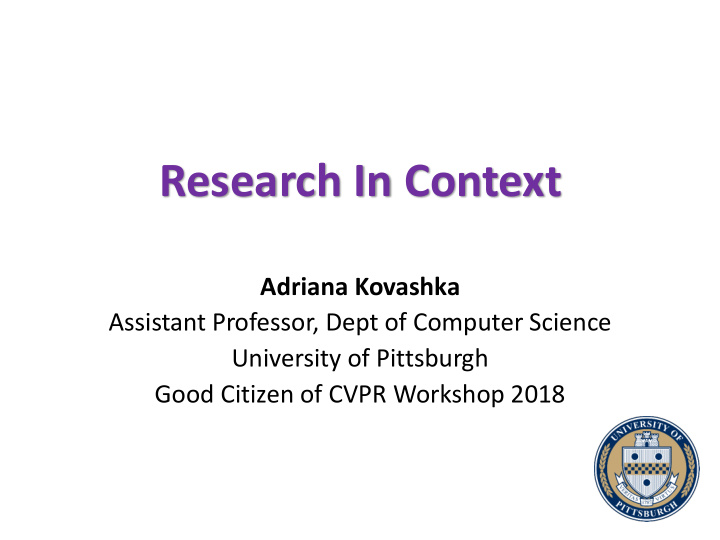



Research In Context Adriana Kovashka Assistant Professor, Dept of Computer Science University of Pittsburgh Good Citizen of CVPR Workshop 2018
What context? • Fact: We do research to understand images automatically. • Context: Where does the average person see images most frequently? • Likely in the media • Context: Who cares about this research? • Impact of persuasive images on society • Outreach and education • Context: Who does this research? • Fostering and mentoring students • Research with undergrads
Persuasive images • Images don’t just passively live in our datasets or our phones • They can be active participants and cause change • A photograph changed public perception of AIDS • A video prompted a change in NFL’s domestic violence policy • A series of photos prompted President Carter to grant asylum to 200,000 refugees • “The general killed the Viet Cong; I killed the general with my camera.” (Eddie Adams)
Persuasive images • Images don’t just passively live in our datasets or our phones • They can be active participants and cause change • Ads helped 100,000 people quit smoking • Nike sales went from $0.8bil (1988) to $9.2bil (1998) • Absolut’s share of the US vodka market went from 2.5% to about 25% • De Beers built the diamond ring industry • Old Spice’s campaign gained 11 million views and 29,000 Facebook fans
Persuasive images • We want to understand what ads tell us to do, and what rationale they provide for doing so • First step to understanding what makes ads effective • But this is challenging for many ads • To enable progress, we developed a large richly annotated dataset: http://cs.pitt.edu/~kovashka/ads
Decoding image advertisements • State-of-the-art vision systems are inadequate to describe the messages hidden behind purposefully designed advertisements. Recognized Concepts Image Captioning people commerce street business stock city A man standing in front of a display of food. Human Interpretation A man standing in front Food at Burger King must taste really of a display of a store. good since even competitor’s employee secretly buys it. Predictions from Clarifai and Vinyals et al.
Others working on understanding persuasion • Jungseock Joo (UCLA) • Jiebo Luo (University of Rochester) • Shih-Fu Chang (Columbia University)
Computer vision with a cause (one example) “ VizWiz Grand Challenge: Answering Visual Questions from Blind People”, Gurari et al., CVPR 2018
Education and outreach • Organizing workshops for the community Calling all students: • It’s not that hard to do and it’s fun • It’s a good networking opportunity • It’s service to the community • Outreach beyond our community Women in Computer Vision Workshop Olga Russakovsky and Fei- Fei Li’s AI4ALL Foundation
Fostering and mentoring students • Doctoral Consortium • Merit-based mentoring event for senior PhD students • Lunch, one-on-one meetings with mentors in academy or industry, panel discussion • Financial support by NSF/industry • Working with undergraduates • First experience was bad, so I decided to never do it again • Then I had a baby, had some time to think of concrete ideas, and agreed to work with three undergraduates • They were all absolutely amazing
Fostering and mentoring students • Teaching undergraduates computer vision • The first time, I only connected with the good students • The third time, we were all cracking jokes every class • Many students were genuinely intrigued; excitement was visible and unrestrained • The key was assuming the students were right and reasonable every time; which they were, unlike before • Good will breeds good will • Undergrads often have an interesting perspective
My “How to be a good citizen of CVPR” • Think about why our research matters • Think about its impact on society • Share datasets and involve community in your work • Reach out to groups outside the community whose involvement and perspective we could benefit from • Help foster graduate and undergraduate students • Involve undergraduates in research and get them excited, they have a lot to contribute!
Recommend
More recommend